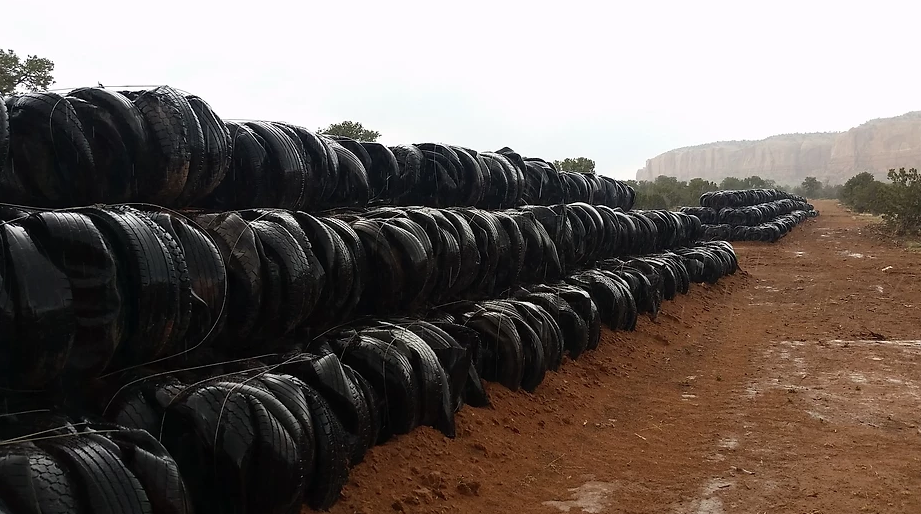Recently Kimi Ishikawa posted this comment on the blog post about building their tire bale house in New Mexico:
I hear people referring to tire bales as “thermal mass” and others referring to them as “insulation.” It can’t be both, right? Aren’t “thermal mass” and “insulation” mutually exclusive? I understand “thermal mass” to be a material that absorbs and stores heat from warmer air, or releases heat to cooler air. I think insulation is something that slows this heat transfer rather than facilitating it.
I have come to think that tire bales act as insulation, and that tire bale walls are considered thermal mass only because of the covering of earthen plaster or concrete stucco. What are others’ take on this, and do you have any sources about this? I am utterly unqualified to speak on this subject, so the above is just my guess. If anyone out there has better or more authoritative info, I would love to hear it, and to hear the source or background of the authority… when I look online for references I see a mix, or I see quotes saying that tire bales offer both thermal mass and insulation.
The confusion might be compounded by earthships, in which individual tires are pounded full of dirt. So wouldn’t that be thermal mass (dirt) surrounded by insulation (tire rubber)? I have leaned against our (so-far uncovered) tire bale walls on sunny cool days, expecting them to be warm in the sun and cool in the shade… but they just seem cool…
(I suppose I shouldn’t care just as long as they work as hoped once our house is finished — it’s just the nerd in me that wants to use the terms accurately.)
This is my response:
All materials lie on a spectrum between insulation and thermal mass. Heavier, dense materials tend to be thermal mass and lightweight materials with lots of pockets of air provide good insulation. For example wood can be both to some extent, where lighter softwood species are more insulating and denser hardwood species have more thermal mass; but neither of these are ideal for either of these applications. I suspect that the rubber in tires is similarly in the mid spectrum.
I think you are right that tire bales would be more insulating because of all the trapped air in those huge bales; the tires used in Earthships are packed with soil, which is pretty good thermal mass.
All of this is mitigated by how a material performs within the envelope of a structure, so it can be confusing for people who might experience adobe as insulating because it effectively stops heat from entering the building for a period of time, even though it is really thermal mass and will radiate that heat back into the building after several hours.

Thanks for this discussion! It really helps my thinking, and makes sense.
I’ll just correct one common misconception — tire bales have nothing to do with straw. They are just tires, wrapped up with very thick baling wire, to make a compressed block of whole tires (with the inevitable big air gaps since tires have enough integrity that you can’t get all the air out when compressing them). The photo Kelly posted above shows stacked tire bales (at our local landfill).
It took many conversations over weeks to get our architect and engineers to understand that we didn’t mean straw bales, and didn’t mean that we were using “tire bales” as infill for stick-built walls! They are baled-tire building blocks.
Thanks again for sharing your expertise, Paul and Kelly! Very helpful.
Thank you for taking the time to explain these concepts.
Hi.
With regard the thermal mass question vs insulative value.
Thermal mass, is prominent in adobe, superadobe, masonry etc, a solid material, that allows the transfer of temperature through the material. These walls often have the capacity to hold a thermal charge, ie being heated by the sun. The logic being that the outside air temperature must drop below the wall temp before the wall is able to release the warmer air. There is simple logic to this, physics. The insulative value of a wall, or material, is it’s capacity to resist the transfer of temperature/air, etc. It is not an ambient system, in terms of construction, it requires that there be additional sources of heat, as it isolates the interior from the exterior, with less/resisted transfer of cold. Temperature/heat/cold, require mass to travel, if we use wool, or hemp, etc, the resistance to the transfer of temperature is great, because there is not a lot to transfer that heat/cold through, and hence why cavity wall (masonry) construction was used, and still used in lot’s of Europe, as they need to create a gap so the cold doesn’t travel right across onto the interior face of the wall.
You’re correct in assuming that with straw filled tires, that the only thermal mass would be found in the plaster and the tires themselves, the straw wouldn’t help much at all, unless compressed with earth, to form a more structured material. Earthships are thermal mass, as the tires are filled with earth, yet still earth isn’t always the best thermal mass store, sand has less thermal capacity than clay, for instance.
Hope this helps a little.
Paul
http://www.havenearth.org